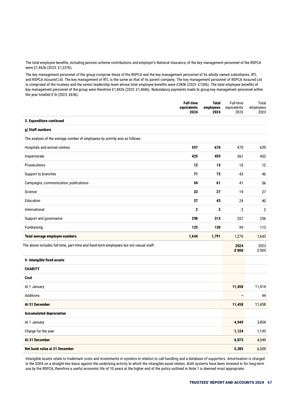
TRUSTEES' REPORT AND ACCOUNTS 2024 67
The total employee benefits, including pension scheme contributions and employer's National Insurance, of the key management personnel of the RSPCA
were £1,462k (2023: £1,337k).
The key management personnel of the group comprise those of the RSPCA and the key management personnel of its wholly owned subsidiaries, RTL
and RSPCA Assured Ltd. The key management of RTL is the same as that of its parent company. The key management personnel of RSPCA Assured Ltd
is comprised of the trustees and the senior leadership team whose total employee benefits were £380k (2023: £130k). The total employee benefits of
key management personnel of the group were therefore £1,842k (2023: £1,468k). Redundancy payments made to group key management personnel within
the year totalled £1k (2023: £65k).
Full-time
equivalents
2024
Total
employees
2024
Full-time
equivalents
2023
Total
employees
2023
3. Expenditure continued
g) Staff numbers
The analysis of the average number of employees by activity was as follows:
Hospitals and animal centres 597 670 470 639
Inspectorate 425 459 361 452
Prosecutions 12 13 10 12
Support to branches 71 73 43 46
Campaigns, communication, publications 54 61 41 56
Science 23 27 19 27
Education 37 43 24 40
International 2 2 2 2
Support and governance 298 313 207 256
Fundraising 125 130 99 113
Total average employee numbers 1,644 1,791 1,276 1,643
2024
£'000
2023
£'000
4. Intangible fixed assets
CHARITY
Cost
At 1 January 11,458 11,414
Additions - 44
At 31 December 11,458 11,458
Accumulated depreciation
At 1 January 4,949 3,804
Charge for the year 1,124 1,145
At 31 December 6,073 4,949
Net book value at 31 December 5,385 6,509
Intangible assets relate to trademark costs and investments in systems in relation to call handling and a database of supporters. Amortisation is charged
in the SOFA on a straight-line basis against the underlying activity to which the intangible asset relates. Both systems have been invested in for long-term
use by the RSPCA, therefore a useful economic life of 10 years at the higher end of the policy outlined in Note 1 is deemed most appropriate.
The above includes full-time, part-time and fixed-term employees but not casual staff.